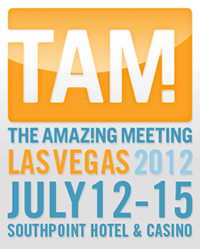In this week’s eSkeptic:

NEW ON MICHAELSHERMER.COM
The Science of Righteousness
Why are we so predictable and tribal in our politics? In Michael Shermer’s June “Skeptic” column for Scientific American, he explains how evolution helps to explain why parties are so tribal and politics so divisive, arguing for the necessity of competition in creating a “livable middle” ground for society.
NEW ON SKEPTICBLOG.ORG
A Weekend of Woo (Or why I love the Esalen Institute)
Michael Shermer recounts his experience at the Esalen Institute this past weekend where he gave a 3-day workshop on “Science, Spirituality, and the Search for Morality and Meaning.”
Lecture this Sunday at Caltech:
Dr. Art Benjamin
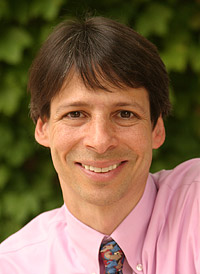
The Secrets of Mental Math: The Mathemagician’s Guide to Lightning Calculation and Amazing Math Tricks
SUNDAY, JUNE 10, 2012 AT 2 PM
Baxter Lecture Hall
Teachers and parents, bring your students and kids to see the famous lightning calculator and mathemagician Art Benjamin demonstrate simple math secrets and tricks that will forever change how you look at the world of numbers. Get ready to amaze your friends—and yourself—with incredible calculations you never thought you could master, and learn how to do math in your head faster than you ever thought possible, dramatically improve your memory for numbers, and—maybe for the first time—make mathematics fun. Dr. Benjamin will teach you how to quickly multiply and divide triple digits, compute with fractions, and determine squares, cubes, and roots without blinking an eye. No matter what your age or current math ability, Dr. Benjamin will teach you how to perform fantastic feats of the mind effortlessly. This is the math they never taught you in school.
Admission policy for Baxter Lecture Hall
Due to security concerns, Baxter Hall will be locked and the audience will be admitted only through the doors on the South side of the building by the lily ponds. If, for medical reasons, you cannot climb the stairs to the hall on the 2nd floor, someone at the main entrance (located in the middle of the West side of the building) will escort you to the elevator.
Tickets
First come, first served at the door. Seating is limited. $8 for Skeptics Society members and the JPL/Caltech community, $10 for nonmembers. Your admission fee is a donation that pays for our lecture expenses.

Spongelab: A Global Science Community
SKEPTICALITY EPISODE 184
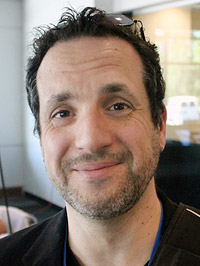
The landscape of education is changing at a pace which might be considered ‘warp speed.’ With tools like Google and Wikipedia, along with a more tech savvy population, new hurdles and challenges face professors and teachers at all levels. Computerized, online media is where many are turning for good resources and content.
In this episode of Skepticality, Derek sits down with Dr. Jeremy Friedberg, the founder and president of Spongelab, an online community which bills itself as “A Global Science Community.” The website is full of resources, digital media, educational computer games, and lesson plans—all of which are free for any educator to use to further enhance their curriculum, and to get students excited about learning the beauty of science and the real world. Find out more about how one company is making sure that science and the real world are communicated in the most effective manner in our modern, cyber-enhanced world.
About this week’s eSkeptic
In this week’s eSkeptic, we present a gem from one of the early issues of Skeptic magazine in which Phil Molé examines some of the teachings and philosophy of Deepak Chopra, and reminds us of the power of science to enlighten. This article appeared in Skeptic magazine volume 6, number 2 (1998).
Phil Molé has a bachelor’s degree in chemistry from DePaul University, where he minored in biology and mathematics. He earned a Masters in Public Health from the University of Illinois at Chicago, and works at an environmental consulting company in Elmhurst, Illinois.
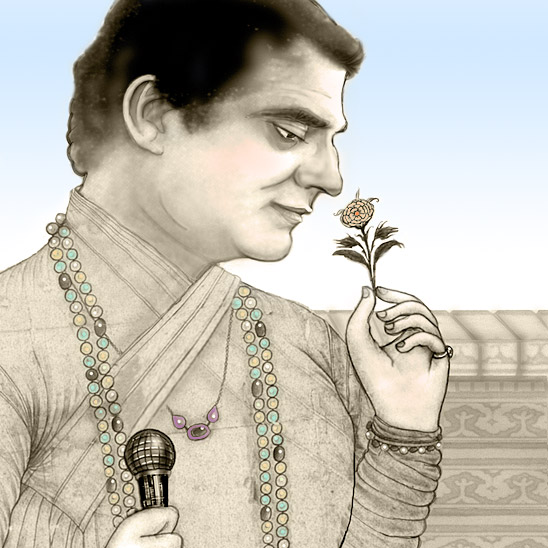
Deepak’s Dangerous Dogmas
by Phil Molé
Through much of history, religious faith was a strong component of medical practice. Diseases were often thought to result from blockages in the body’s flow of vital forces, or from possession by malevolent spirits. Eventually, scientific medicine far surpassed efforts of faith healers, so the latter was made to yield authority to the former.
Occasionally, however, vestiges of the old system creep back in. The current attention given to mind-body medicine — and its most prominent practitioner, Deepak Chopra — testifies to this fact. The author of 19 books, Chopra gives seminars around the world, releases numerous videotaped lectures, and has his own line of herbs and aromatic oils. He also boasts of an impressive celebrity clientele, including Demi Moore, Elizabeth Taylor, George Harrison, and Michael Jackson. Former Good Morning America anchorwoman Joan Lunden even described him as a “huge influence” on her life (Lunden, 20).
The content of Chopra’s philosophy is often obscured by logical inconsistencies, but it is possible, nonetheless, to identify its key components. First, he views the body as a quantum mechanical system, and uses comparisons of quantum reality with Eastern thought to guide us away from our Western, Newtonian-based paradigms. Having accomplished that, he then sets out to convince us that we can alter reality through our perceptions, and admonishes us to appreciate the unity of the Universe. If we allow ourselves to fully grasp these lessons, Chopra assures us, we will then understand the force of Intelligence permeating all of existence — guiding us ever closer to fulfillment. Each component of this philosophy has serious flaws, and requires individual analysis.
The Great Quantum Paradigm Shift
To understand why Chopra is trying to nudge us Eastward in our philosophies, we must first understand the nature of mystical thought, and its rise to prominence in American culture. Mysticism, of course, has been part of our intellectual heritage for thousands of years, originating with ancient Greek thinkers such as Plato and Heraclitus. Eastern religions such as Buddhism, Hinduism, and Taoism expressed similar sentiments, in more developed and poetic forms. There are many varieties of mysticism, but all of them share the four characteristics elaborately described by Bertrand Russell in his classic essay “Mysticism & Logic.” All mystics believe in sudden insight — a revelation of irrefutable knowledge unavailable to the senses; they believe in the oneness of all matter, and the unreality of opposites; they deny the reality of time, since the “past” and the “future” are merely opposite terms resulting from deluded human thought; and they deny the existence of evil.
In 1975, mysticism received its first forceful endorsement from a member of the scientific community. Physicist Fritjof Capra, in his enormously successful book The Tao of Physics, speculated elaborately about the similarities between the science of the subatomic world and the philosophy of Eastern sages. Capra believed these similarities could not be due to chance alone and claimed that the wave particle duality of matter, the Heisenberg uncertainty principle, the equivalence of mass and energy, the Copenhagen Interpretation of quantum mechanics and Einstein’s relativity theories were specific affirmations of mystic principles. Like any mystic worth his salt, he developed this theory through sudden insight:
I was sitting by the ocean late one summer afternoon, watching the waves rolling in and feeling the rhythm of my breathing, when I suddenly became aware of my whole environment as being engaged in a gigantic cosmic dance I saw cascades of energy coming down from outer space, in which particles were created and destroyed in rhythmic pulses; I saw the atoms of the elements and those of my body participating in this cosmic dance of energy; I felt its rhythm and I heard its sound, and at that moment I knew that this was the dance of Shiva, the Lord of the Dancers worshipped by the Hindus (Capra, 11).
To his credit, Capra distinguished between the physical laws pertaining to subatomic entities — and objects traveling near the speed of light, and the physical laws pertaining to boring, macroscopic classical matter — like us. He merely stated that 20th century physics has shown us a different side of reality, and suggested we should change not only our scientific paradigms, but also our social ones, to correspond more closely with the findings of Planck, Einstein and Bohr. This, of course, is still a rather flawed thesis, as I will explain shortly.
Chopra, however, takes a stance that makes Capra look staunchly conservative. In essence, he asserts that our bodies should no longer be regarded as solid mass in the strict Newtonian sense, because they’re made of atoms, which are governed by the laws of quantum mechanics. Therefore, he argues, we must abandon our old views of our bodies, because they do not represent our true reality. “This way of seeing things — the old paradigm,” he tells us in Ageless Body, Timeless Mind, “has aptly been called the ‘hypnosis of social conditioning,’ an induced fiction in which we have collectively agreed to participate (4).” There’s no qualification of meaning attempted here: Chopra is saying the Newtonian-based image of our bodies is wrong, and the quantum-mechanical image of our bodies is right. Since he, like Capra, finds profound similarities between quantum mechanics and mystical thought, the maxims of Eastern sages are automatically fashioned into the guideposts of our life.
Examined credulously, Chopra’s argument seems persuasive. There certainly seems to be some resemblance between, say, the Buddhist assertion that matter and empty space are the same, and the fact that atoms, “the building blocks of matter,” are mostly empty space. Yet, arguments based on superficial logic are not only persuasive, but also dangerous, since they may lead us into errant patterns of thinking. This is the nature of Chopra’s argument, which finds connections where there may be none, and recklessly superimposes the laws of one level of reality on the matter of another.
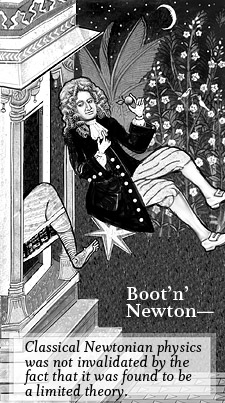
Chopra’s plea for a paradigm shift, ironically, seems to stem from the very dichotomous thinking abhorred by mystics for centuries. If classical physics has been proven to be limited, he reasons, then it must not contain any “real” truth. Modern physics, with all of its new laws and insights, must therefore represent the deeper reality. But this “either/or” business of choosing paradigms is patently absurd, because modern and Newtonian physics are both perfectly valid theories in their own rights and within their own applications. The classical model is a perfectly good description of macroscopic objects moving at relatively low velocities — it only breaks down when matter approaches subatomic size, or when it travels at velocities near the speed of light. Quantum mechanics also has its breaking point: at sizes somewhat bigger than that of a single atom, quantum effects such as wave-particle duality are no longer observed. It would be just as valid, from Chopra’s narrow viewpoint, to point to this limitation in quantum mechanics as proof that classical physics is the one true model of reality. For our bodies, the classical view is clearly the most accurate, since we’re well beyond the size limit of quantum-mechanical nature.
One of Chopra’s chief problems is his inability to realize that a limited theory is not quite the same as an incorrect theory. In fact, all theories are limited, because any models we develop are only selective approximations of reality. Russell said it best: “Science…encourages abandonment of the search for absolute truth, and the substitution of what may be called ‘technical truth,’ which belongs to any theory that can be successfully employed in inventions or in predicting the future” (Russell, .93). All that matters is that we can use a theory to make certain predictions in certain circumstances, and test the predictions through experiment and observation.
Astrophysicist John Gribbin, in his brilliant book Schrödinger’s Kittens and the Search for Reality, explored this point in more detail. Discussing our various models of the atom, and their “goodness” in different applications, Gribbin issued the following caveat:
The point is that we do not know what an atom is really, we cannot ever know what an atom is really. We can only know what an atom is like. By probing it in certain ways, we find that, under certain circumstances, it is like a billiard ball. Probe it another way, and we find it is like the Solar System. Ask a third set of questions, and the answer we get is it is like a positively charged nucleus surrounded by a fuzzy cloud of electrons. These are all images that we carry over from the everyday world to build up a picture of what an atom is. We construct a model, or an image; but then, all too often, we for get what we have done, and confuse the image with reality (Gribbin, 186).
It’s all very well to use models to describe the world, but we must remember that a model only gives us part of the overall picture. Considering any model to somehow contain all of reality is like imagining the globe in our den is a complete reproduction of Earth.
Furthermore, there’s no reason to say that the apparent similarities between quantum theory and mysticism are anything other than coincidental. Again, because of our dichotomous nature, we haven’t been able to think of very many descriptions of existence. We tend to think of something as being either hard or soft, permanent or changeable, solid or empty, united or separate. Should we be surprised if certain theories of science conform to one set of these descriptions?
This point can best be demonstrated by considering the age old philosophical example of a glass filled with water to exactly 50% of its volume. Are we best advised to consider the glass to be half empty, or half full? We seem to be awfully limited in our descriptive freedom. Yet, our answer depends entirely on what we’re trying to learn. If we wish to measure the volume of air inside the glass, it makes sense to consider it to be half empty. But if we’re trying to measure the mass of the glass and water system, we’d better model it as being half full! Taking this a step further, we can see how certain sets of measurements (i.e., mass) will tend to confirm the “half-full” theory, while another set, (i.e., air volume) will win us over to the “half-empty” theory. Which is correct? Both! As Isaac Asimov succinctly stated, “theories are not so much wrong as incomplete (Asimov, 298).”
Chopra, by implying that quantum mechanics is the true face of reality, and by exploiting coincidental parallels with mysticism, leads us into shallow logical waters. It’s one thing to say that a theory or philosophy demonstrates previously unknown features of our existence, it’s quite another to say it is the fundamental truth of our existence, and necessitates a paradigm change.
Create Your Own Reality
In “The Mysterious Stranger,” one of my favorite short stories by Mark Twain, the protagonist, Theodor Fischer, becomes severely disillusioned with life. Accompanied by an angel curiously named Satan, Fischer sees the dark underbelly of life, and the apparent hopelessness facing all of humanity. At the end of the story, his good spirits are restored when his angelic companion tells him that reality — with all of its trials and tribulations — is nothing more than a thought in his head. “Life itself is only a vision, a dream,” Satan tells him. The effect on Fischer was immediate: “A subtle influence blew upon my spirit…bringing with it a vague, dim but blessed and hopeful feeling that the incredible words might be true — even must be true” (Twain, 678).
Like Fischer, Chopra finds great satisfaction in confining reality to the dimensions of our brain. One of his favorite developments in 20th century physics is the Copenhagen Interpretation of quantum mechanics. The interpretation covers many aspects of the quantum world — uncertainty, complementarity, probability — but Chopra is mainly interested in what it says about the relationship between the observer and the observed. To quote physicist Heinz Pagel: “There is no meaning to the objective existence of an electron at some point in space independent of actual observation (Davies, 143).” The implications of this statement are enormous — it tells us an electron only exists as a probability until someone looks at it! Yet, the Copenhagen Interpretation thrived for a half century, because it made predictions verified by experiment. In the process, it also inspired a slew of philo- sophical questions of the “tree falling in the forest” variety.
Chopra uses the Copenhagen mystique to argue that our bodies are made of atoms, which are at the mercy of the observer, so we have the ability to change our body through mental acts of will. Thus, he claims, “the physical world, including our bodies, is a response of the observer. We create our bodies as we create the experience of our world” (Chopra, 1993, 7). Furthermore, he says, Einstein showed us time can flow at different rates through space-time, so why shouldn’t we be able to slow it down or stop it as we see fit? In fact, why shouldn’t we be able to reverse its flow direction, and make ourselves younger? After all, the Copenhagen Interpretation of quantum mechanics subordinates matter to our senses — why shouldn’t time be included in our dominion? If Chopra’s argument is true, the havoc I can play with reality appears boundless. I could, it seems, send all of the atoms in my right hand to Pluto right now, if I really want to. (I don’t; they’re busy typing at this moment).
There are, of course, a few snags in Chopra’s argument. First, even if we believe the human body can realistically be treated as a quantum-mechanical system (as explained before, it cannot be), and believe the Copenhagen Interpretation is the only viable model for quantum mechanics (it isn’t), we cannot assume that time can be molded to fit our observations. It’s true that an observer moving at very high velocities will experience time flowing at a slower rate, but he must first find a way to increase his speed quite significantly. Observation alone cannot alter the passage of time. Also, relativity theory and quantum mechanics have not yet been combined with any success, so time cannot be considered a quantum entity subject to observational influence.
There is another problem we must lay at Chopra’s doorstep — a problem concerning the large portion of our bodies hidden from our view. Quantum mechanics experiments have shown us that only acts of direct observation can collapse a probability function and cause a real particle to appear. In order to truly influence our bodies, therefore, we would have to observe all of the atoms in the body parts we wanted to heal. But how can someone with lung cancer, for instance, “observe” the atoms deep inside his chest cavity? How can a potential heart attack victim “see” the atoms of calcium forming plaques in his arteries?
Chopra tries to get around this issue by saying perception is what really matters. “You can change your world—including your body—simply by changing your perception (17),” he states in Ageless Body, Timeless Mind. He makes this transition in terms—from “observation” to “perception,” quite rapidly, as if they meant the same thing. They don’t. Observation pertains to what we see, and perception pertains to our interpretation of what we see. This is an important distinction, because the results of quantum mechanics experiments bear no relation to our ideas, after the fact, of what happened during the experiment. The wave functions are collapsed by the act of taking a measurement itself. Chopra confuses his terminology further in other parts of his books, talking about perceiving when he seems to really be discussing visualizing. His reliance on the Copenhagen Interpretation has now been completely shattered. If we merely visualize what we think will happen in a quantum mechanics experiment, without taking a measurement, we won’t collapse the wave function, and we will play no role in the experiment at all!
Although I’ve just killed Chopra’s fantasies of quantum mechanical bodies created by our perceptions, it couldn’t hurt to kick the corpse just one more time. Chopra relies heavily on the Copenhagen Interpretation, and seems to imply to his readers that it is the only quantum mechanical model in existence. This was true for quite a long time, but it is certainly not true anymore. Physicist John Cramer has developed a “transactional” model using the Wheeler-Feynman theory of electromagnetic radiation, and it predicts the results of quantum mechanics experiments just as well as the “old” model does. It’s even more attractive, however, because the observer has no special role in the model’s explanation of quantum mechanics—so objective reality exists, after all! Of course, this is still just a theory, but it’s quite a good one, and it may put ideas about observer-created realities out to pasture once and for all.
The Unity of Everything
Mystics have always emphasized the belief that opposites are aspects of the same reality, and our tendency to view entities as separate and unrelated stems from limits in abstract thinking. Heraclitus, for example, was fond of maxims such as “good and ill are one” and “the way up and the way down is one and the same.” The same idea was beautifully expressed by Lao Tsu in the Tao Te Ching (2):
Under heaven all can see beauty as beauty
only because there is ugliness.
All can know good as good only because there is evil.
Therefore, having and not having arise together.
Difficult and easy complement each other.
Long and short contrast each other;
High and low rest upon each other;
Voice and sound harmonize each other;
Front and back follow one another.
There is great value in this lesson; it’s always helpful to confront our old ways of thinking in order to gain a better and fuller perspective of the world. A little thought shows us many instances of ideas and things which were once considered independent, but now have a recognized relationship. In sociology, this was demonstrated in the “nature” versus “nurture” debate. The 17th-century philosopher John Locke, with his “tabula rasa” view of humanity, felt every aspect of man’s character was influenced entirely by culture—man was a fountain of limitless possibilities. This view contrasted sharply with that of many other folks, who felt certain races of man (usually whites of European descent) were biologically superior to others. We now generally recognize that nature and nurture both play a role in determining who we are. All human populations are genetically remarkably alike, but this just means that we all have essentially the same genetic “hardware,” and are not unlimited in the types of “human nature” we exhibit. Culture serves as the “software” that produces variations within our common genetic heritage. Discerning the relationship between “nature” and “nurture,” previously thought to be mutually exclusive, is one of our greatest human achievements.
Still, there should be two limits imposed on our quest for unity in the world. The first concerns attempted unification of disciplines which can only function effectively in isolation, and the second involves false assumptions that all doctrines based on unity are automatically “good.”
Chopra, extending the logic of his rally for a new paradigm shift, wholeheartedly endorses the unification of medicine and spirituality. In many of his books, he bewails the way doctors seem obsessed with “disease and cure” (Chopra, 1988, 91), treating patients as receptacles for medical treatments instead of living, intelligent beings. His solution is to develop a new model of medicine relying heavily on meditation— a practice he believes will enable us to alter the quantum- mechanical structure of our bodies. Traditional medicine should still be used, he explains, but it should not be considered our only alternative.
Medicine (a science) and Eastern spirituality (a religion) share the same goal: helping human beings maintain harmony between their minds and bodies. The approaches used, however, are quite different. Medical science is born of observation, and develops inductively and deductively from testing observations through an endless array of experiments and verifications. Only after a medical theory or procedure has been vigorously tested against reality does it become a standard part of medicine, and even then it is always amenable to new evidence. This is the best method to ensure the reliability of techniques, and to protect patients from receiving treatments which further deteriorate their health or fill them with false hopes.
Religions, on the other hand, begin with certain assumptions about the world and proceed deductively inward. Because the principle assumption is usually the bedrock of the religion, and is therefore considered indisputably factual, all ideas deduced from the assumption are also considered infallible. Spirituality is not subjected to the rigors of experiment, nor is any other attempt generally made to validate its ideas.
We can see, then, that there is no way to reconcile the methodologies of science and religion. Spirituality may be practiced by an individual, as long as it does not interfere with the prescriptions of true medicine. To claim religion as a substitute for medical science is equivalent to claiming astrology as a substitute for astronomy, or for that matter, Creationism as a substitute for evolutionary biology. There is no way of doing so without bringing religion under unnecessarily harsh scrutiny, or undermining the very mechanics by which science operates—endangering human welfare in the process.
A further caution against Chopra’s doctrine of unity is that the feeling of unity itself creates such a feeling of goodness, that it causes us to regard all holistic doctrines as being ineffably good. In other words, when the distinction between good and evil is erased, we tend to feel that only the good survives. Or, as Chopra said in The Way of the Wizard, “beyond the play of opposites, Merlin said, lies a timeless realm of pure light, pure Being, pure love” (126). But why should it be good, and not evil, that still remains after the mirage of opposites has dissipated? Is it realistic to think that holistic philosophies are exempt from any evil, whatsoever?
No. Holistic paradigms come with their own sorts of problems. As Stephen Jay Gould has pointed out, holistic worldviews in pre-Newtonian Europe were often used to justify social inequalities; each person was seen to be fulfilling a role, no matter how menial, in the support of the larger machine of government. “PreCartesian holism was more than a bucolic perception of nature’s fundamental unity,” Gould says, “it was also a dandy doctrine to enforce a status quo not blissful for everyone” (Gould, 220). In our search for universal synchronicity, we must be aware of what we are trying to unify, and the reasons why we’re trying.
Unseen Intelligence
A recurring theme in Chopra’s books concerns the Intelligence of the Universe— the notion that all of existence preserves its own order through a form of consciousness. The good news for us, he then says, is that the Universal Intelligence will provide us with anything we desire. Since we are just forms of energy living in harmony with all other existing energies, the universe maintains us in the process of maintaining itself. Our consciousness somehow melds with the Cosmic Consciousness, and informs it of our wishes. “In order to acquire wealth, or for that matter anything in the physical universe,” Chopra proclaims in Creating Affluence, “you must intend it, make a decision to go for it. The universe handles the details, organizes and orchestrates opportunities. You have simply to be alert to these opportunities” (37). When we wish upon a star, he tells us, our dreams really do come true.
The idea of a consciously evolving universe is quite similar to the strong anthropic principle in cosmology. Some researchers have attached deep meaning to the fact that the four forces (gravity, electromagnetism, strong, and weak) seem to have been “fine tuned” to allow life to develop. If the force of gravity had been just a little bit weaker, they say, denser regions of the universe would never have had the chance to condense into the stars and planets we see today; and if the strong force had been weaker, atomic nuclei couldn’t have been formed. This seems, to them, to be evidence of some form of Intelligence guiding the universe to conditions suitable to support life.
This argument is ultimately rather circular. Why do the forces have the values they do? So human beings could be created. Why were human beings created? Because the strengths of the four forces allowed them to be. But the theory glosses over the fact that vast sections of the universe are completely unsuitable for life. If a guiding principle existed, wouldn’t it also provide for the existence of life in these areas? Furthermore, some theorists, such as Michio Kaku, believe that our universe may be one of billions of cosmic bubbles that have burst into existence. There’s a real statistical probability that some of these “bubble universes” would have conditions hospitable to life, so we need not obsess over the intricate clockwork of existence. The universe may just appear tailor made for us because we are here to see it.
Needless to say, it’s also completely wrong, and potentially very dangerous, to think of the universe as a benevolent Field seeking to make us infinitely happy. This notion, with absolutely no basis in fact, absolves us of responsibility for our own life, and leaves us vulnerable to every imaginable calamity. Following Chopra’s advice, and placing our lives in the hands of the universe, is like flinging gold dust into the wind. We lose the ability to control our fate, and avoid life’s assorted snags and pitfalls, if we automatically assume things will just work out for the best. We become like Voltaire’s Candide, who believes, despite overwhelming evidence to the contrary, that he lives in “the best of all possible worlds” (Voltaire, 243).
The Burden of Proof
When your claims and practices cannot be logically defended, it’s imperative to stay clear of damning evidence. This is something Chopra does with undeniable skill—upholding any indications, no matter how uncertain, of his philosophy’s successes and caustically dismissing challenges to their validity. In his autobiography Return of the Rishi, he describes an incident in which he and a congregation of meditators assembled to demonstrate the art of yogic flying, or levitation, to a television crew. (According to Chopra, humans can levitate by melding their consciousness with the unified field.) When clinical psychologist William Polonski told Chopra his “flyers” looked a lot more like hoppers, the guru became furious: “I think it’s the height of arrogance to educate oneself with four or five years of medical school and three years of training, and then to argue with a tradition that has existed unbroken for five thousand years” (193). So much for open debate.
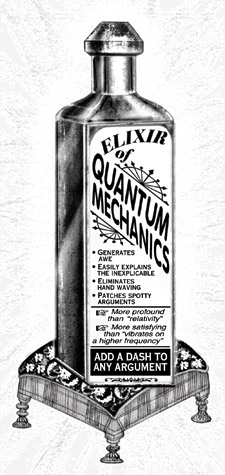
Quantum Healing provides a similar example of Chopra’s hostility toward skeptical inquiries. He described an experiment by French immunologist Jacques Benveniste regarding the allergic response mediated by the antibody IgE. Benveniste was trying to find out how much anti-IgE was needed to trigger an immune response, and used successively dilute samples of the anti-IgE stock solution. To his amazement, he found that a complete dilution, containing no anti-IgE whatsoever, elicited the same immune response as the stock solution! Chopra maintained this was an example of quantum intelligence—the water had “remembered” it once contained anti-IgE, and the human IgE cells accessed the memory and reacted accordingly.
I can’t, for all the world, understand why phantom immune responses indicate intelligence; they seem, if they exist, to be a better example of ignorance. If our immune system could be triggered by water, we’d swell up like a pufferfish every time we drank something. Luckily for us, Benveniste’s results were almost certainly due to error. Although he was able to duplicate his original results 70 times without the scrutiny of his peers, he could not achieve them in the presence of investigators sent by Nature magazine. A simple error, a delusion, or possibly both, caused him to attain his absurd findings.
True to form, Chopra blasted the staff of Nature for being “reluctant to walk through the quantum door, though this experiment clearly opens it” (120). How does he explain subsequent failures to reproduce the results? “Since the ability of water to remember is inexplicable, its ability to forget can hardly be held against it” (120). How convenient.
Chopra has also been less than scientific in documenting the effectiveness of his herbal remedies. In a 1993 article in Journal of the American Medical Association, Chopra used vague terminology, referring to one costly concoction as “pure knowledge pressed into material form” (Van Biema, 67). No evidence from peer reviewed studies was cited to justify his claims. This, along with Chopra’s failure to disclose his financial interest in the remedies, prompted the editors of JAMA to question his ethics; he retaliated by filing a lawsuit against the journal. (He eventually dropped the case).
But doctors, more than anyone, should be held accountable for the claims they make. If they were allowed to recommend any procedures and remedies uncorroborated by strong evidence, the public would be placed in great jeopardy. At best, many people would spend money unnecessarily, as they often do for herbal dietary supplements which have not been validated through controlled studies. (St. John’s Wort, a popular antidepressant, is one of the few that do have documented effectiveness). At worst, they may lose their lives. This was the fate of David Flint, a leukemia patient treated by an Ayurvedic “physician” endorsed by Chopra. After spending $10,000 over nine months, Flint was allegedly pronounced cured. He died shortly thereafter.
There is no danger in some of Chopra’s advice, of course. He is most lucid when discussing the proven relationship between stress and health, and recommending relaxation strategies to reduce our anxiety. Many diseases may be helped by a positive frame of mind. Back and knee pains, headaches, stuttering, ulcers, stress, hay fever, asthma, hysterical paralysis and blindness are all diseases in which the state of mind may play a central role (Sagan, 234). There are also many diseases, however—such as leukemia and diabetes—which only modern medicine has been able to treat with any success. To stay out of trouble, we must stop substituting our willingness to believe in a “cure” as proof of its effectiveness. We must remember, as Carl Sagan was fond of saying, that spectacular claims require spectacular evidence.
Conclusions: The Path to Enlightenment
It’s human to be hopeful. “Hope is what drives all of us— skeptics and believers alike—to be compelled by unsolved mysteries, to seek spiritual meaning in a physical universe, desire immortality, and wish that our hopes for eternity may be fulfilled” (Shermer, 6). When someone tells us we don’t have to grow old, evil isn’t real, and the universe caters to our wishes, we passionately want to believe. But this is the very reason we must exercise skepticism.
Mystics such as Chopra have always felt that enlightenment comes in sudden, piercing revelation. Science, in contrast, seeks enlightenment based on rigid investigations of reality, correlating its observations based on proven and repeatable experimental results. Of the two methods, only science has the power to provide a check against the pitfalls of faulty logic. To Chopra, the scientist’s world may not seem as magical as the mystic’s, but it provides us with something not even Merlin could have conjured up: the power to control our own fate. If we heed this lesson, and give figures such as Chopra the required analysis, we’ll truly be heading down the Path to Enlightenment.
Bibliography
- Asimov, Isaac. 1988. The Relativity of Wrong. New York: Pinnacle.
- Brown, Chip. “Deepak Chopra Has a (Sniff) Cold.” Esquire. October, 1995.
- Capra, Fritjof. 1975. The Tao of Physics. An Exploration of the Parallels Between Modem Physics and Eastern Mysticism. Boston, MA. Shambhala.
- Chopra, Deepak. 1993. Ageless Body, Timeless Mind: The Quantum Alternative to Growing Old. New York: Random House.
- ___. 1993. Creating Affluence: Wealth Consciousness in the Field of All Possibilities. San Rafael, CA: New World Library.
- ___. 1989. Quantum Healing: Exploring the Frontiers of Mind/Body Medicine. 1989. New York: Bantam. ___. 1988. Return of the Rishi: A Doctor’s Search for the Ultimate.
- Healer. Boston, MA: Houghton Mifflin Company.
- ___. 1994. The Seven Spiritual Laws of Success: A Practical Guide to the Fulfillment of Your Dreams. San Rafael, CA: New World Library.
- ___. 1995. The Way of the Wizard: Twenty Spiritual Lessons in Creating the Life You Want. New York: Harmony Books.
- Davies, Paul (ed.). 1989. The New Physics. Cambridge: Cambridge University Press.
- Freeman, Derek. 1997. “Paradigms in Collision.” Skeptic, 5:3.
- Gould, Stephen Jay. 1987. An Urchin in the Storm: Essays about Books and Ideas. New York: W.W. Norton and Company.
- Gribbin, John. 1984. In Search of Schrodingers Cat: Quantum Physics and Reality. New York: Bantam.
- ___. 1995. Schrodingers Kittens and the Search for Reality: Solving the Quantum Mysteries. New York: Little, Brown and Company.
- Kaku, Michio. 1994. Hyperspace: A Scientific Odyssey Through Parallel Universes, Time Warps, and the 10th Dimension. New York: Oxford University Press.
- Leland, John, and Power, Carla. “Deepak’s Instant Karma.” Newsweek. October 20, 1997.
- Lunden, Joan. “My Survival Secrets.” McCalls. July, 1997.
- Pettus, Elise. “The Mind-Body Problem.” New York August 14, 1995.
- Russell, Bertrand. 1981. Mysticism and Logic. Totowa, New Jersey: Barnes and Noble Books.
- ___. 1935. Religion and Science. New York: Oxford University Press. Excerpted in Macleod, et.al. 1991. Writing About the World. New York: Harcourt Brace Jovanovich College Publishers.
- Sagan, Carl. 1996. The Demon Haunted World: Science as a Candle in the Dark. New York: Ballantine Books.
- Shermer, Michael. 1997. Why People Believe Weird Things: Pseudoscience, Superstition, and other Confusions of Our Time. New York: W.H. Freeman and Company.
- Stix, Gary. “Plant Matters: How Do You Regulate An Herb?” Scientific American. February, 1998.
- Trefil, James. “Was the Universe Designed for Life? Coming to Terms With the Anthropic Principle.” Astronomy. June, 1997.
- Twain, Mark. 1957. “The Mysterious Stranger.” The Complete Short Stories of Mark Twain. New York: Bantam.
- Tsu, Lao. 1997. Tao Te Ching. New York: Vintage Books.
- Van Biema, David. “Of the Soul.” Time. June 24, 1996.
- Voltaire. 1985. The Portable Voltaire. Ed. B.R. Redman. New York: Penguin.
Skeptical perspectives on quantum mechanics…
-
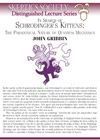 In Search of Schrödinger’s Kittens
In Search of Schrödinger’s Kittens
by John Gribbin -
Astrophysicist and science writer John Gribbin explains the bizarre and quirky world of quantum mechanics and devises a solution to Einstein’s paradox and what he called “spooky action at a distance.” Order the lecture on DVD.
-
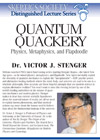 Quantum Quackery: Physics, Metaphysics, and Flapdoodle
Quantum Quackery: Physics, Metaphysics, and Flapdoodle
by Dr. Victor J. Stenger -
Dr. Stenger shows that because quantum mechanics is obscure it is often misused to explain the “unexplainable”—ESP, psychic power, etc. But quantum mechanical hypotheses fit the facts of material reality quite well without any need at all to call upon mysticism. Order the lecture on DVD.
-
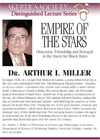 Empire of the Stars: Obsession, Friendship, and Betrayal in the Quest for Black Holes
Empire of the Stars: Obsession, Friendship, and Betrayal in the Quest for Black Holes
by Arthur I. Miller -
Dr. Miller discusses two great theories: relativity and quantum mechanics, which meet head on in the description of black holes. Miller recounts the dramatic story of the quest to understand black holes and the feud between the great astrophysicist Sir Arthur Eddington and his rival, the young Indian imigrant Subrahmanyan Chandrasekhar.
Order the lecture on DVD.
Announcing The Amaz!ng Meeting 2012
Southpoint Hotel & Casino, Las Vegas, NV
July 12–15, 2012
THE AMAZ!NG MEETING (TAM) is an annual celebration of science, skepticism and critical thinking. People from all over the world come to TAM each year to share learning, laughs and the skeptical perspective with their fellow skeptics and a host of distinguished guest speakers and panelists.
The James Randi Educational Foundation (JREF) has hosted its annual Amaz!ng Meeting since 2003 as a way to promote science, skepticism and critical thinking about paranormal and supernatural claims to the broader public. TAM has been held in Las Vegas, NV since 2004 and has become the world’s largest gathering of like-minded science-advocates and skeptics.
With yet another incredible lineup of speakers, hands-on workshops, and entertainment, this is sure to be an Amaz!ng Meeting you won’t want to miss! Check out the entire program, and follow @jref on Twitter for the latest #TAM2012 news and announcements.


